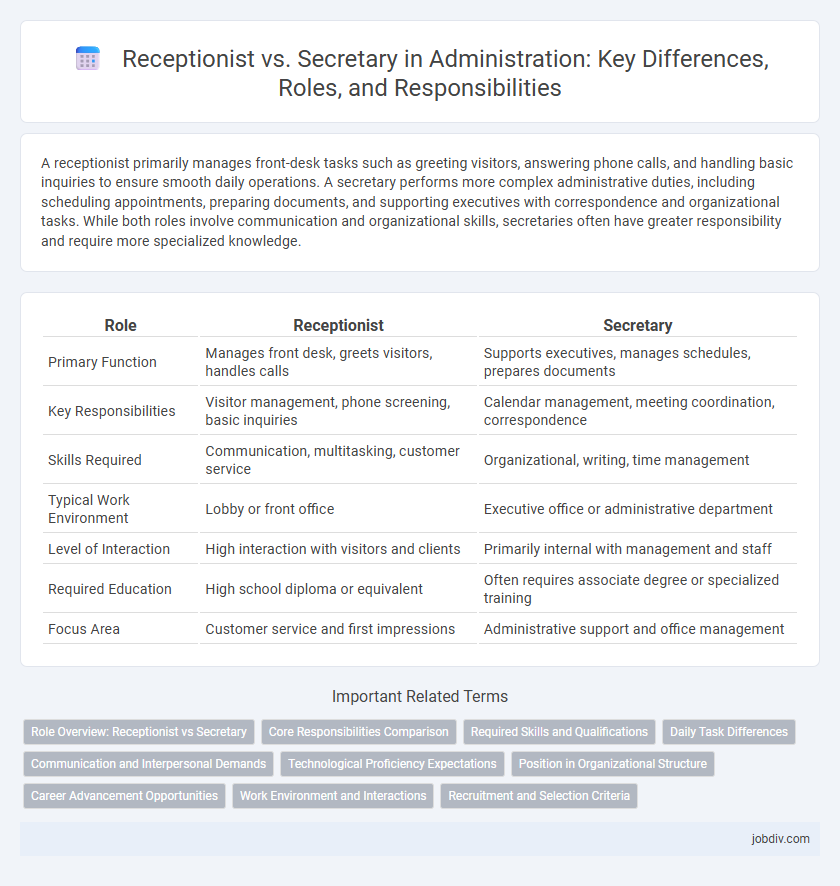A receptionist primarily manages front-desk tasks such as greeting visitors, answering phone calls, and handling basic inquiries to ensure smooth daily operations. A secretary performs more complex administrative duties, including scheduling appointments, preparing documents, and supporting executives with correspondence and organizational tasks. While both roles involve communication and organizational skills, secretaries often have greater responsibility and require more specialized knowledge.
Table of Comparison
| Role | Receptionist | Secretary |
|---|---|---|
| Primary Function | Manages front desk, greets visitors, handles calls | Supports executives, manages schedules, prepares documents |
| Key Responsibilities | Visitor management, phone screening, basic inquiries | Calendar management, meeting coordination, correspondence |
| Skills Required | Communication, multitasking, customer service | Organizational, writing, time management |
| Typical Work Environment | Lobby or front office | Executive office or administrative department |
| Level of Interaction | High interaction with visitors and clients | Primarily internal with management and staff |
| Required Education | High school diploma or equivalent | Often requires associate degree or specialized training |
| Focus Area | Customer service and first impressions | Administrative support and office management |
Role Overview: Receptionist vs Secretary
Receptionists handle front desk duties, managing visitor greetings, phone calls, and appointment scheduling to ensure smooth daily operations in offices or organizations. Secretaries provide comprehensive administrative support, including document preparation, correspondence management, and coordination of meetings, often requiring specialized knowledge in business practices. While receptionists emphasize customer interaction and initial communication, secretaries focus on detailed organizational tasks that enhance executive efficiency.
Core Responsibilities Comparison
Receptionists primarily handle front desk duties such as greeting visitors, managing phone calls, and scheduling appointments, ensuring smooth first impressions and efficient communication flow. Secretaries focus on administrative support including preparing documents, managing correspondence, organizing meetings, and maintaining records to assist executives or departments. Both roles require strong organizational skills but differ in scope, with receptionists emphasizing client interaction and secretaries concentrating on internal administrative tasks.
Required Skills and Qualifications
Receptionists require strong communication skills, proficiency in handling multi-line phone systems, and basic computer literacy to manage scheduling and inquiries efficiently. Secretaries need advanced organizational abilities, expertise in document preparation, and familiarity with office software suites like Microsoft Office and Google Workspace. Both roles demand professionalism, time management skills, and the ability to multitask effectively in fast-paced environments.
Daily Task Differences
Receptionists manage front desk operations by greeting visitors, answering phone calls, and handling basic inquiries, ensuring smooth first impressions. Secretaries perform more specialized administrative duties such as scheduling meetings, preparing documents, and managing correspondence for executives or departments. The receptionist's tasks emphasize customer interaction and initial communication, while secretaries focus on detailed organizational support and office workflow management.
Communication and Interpersonal Demands
Receptionists primarily handle front-desk communication, managing incoming calls, greeting visitors, and coordinating appointments, requiring strong verbal and non-verbal interpersonal skills. Secretaries often engage in more complex communication tasks, such as drafting correspondence, coordinating meetings, and liaising between executives and staff, demanding advanced written communication and organizational abilities. Both roles require excellent interpersonal skills, but secretaries typically face higher demands for discretion, multitasking, and professional communication within organizational hierarchies.
Technological Proficiency Expectations
Receptionists are expected to master basic office software, phone systems, and scheduling tools to manage front-desk operations efficiently. Secretaries often require advanced proficiency in word processing, spreadsheet management, and specialized administrative software to support executive tasks. Both roles demand adaptability to evolving technologies, but secretaries typically handle more complex digital documentation and communication platforms.
Position in Organizational Structure
A receptionist typically holds an entry-level position within the organizational structure, often reporting directly to the front office manager or administrative supervisor. Secretaries generally occupy a mid-level role, supporting higher management such as department heads or executives with specialized administrative tasks. The secretary's position integrates more closely with strategic communication and document management, reflecting greater responsibility compared to the receptionist's front-line, customer-facing duties.
Career Advancement Opportunities
Receptionists typically start with entry-level administrative tasks, gaining experience in customer service and office management, which can lead to roles like office coordinator or administrative assistant. Secretaries often handle more complex responsibilities, such as managing executive schedules and preparing official documents, positioning them for advancement to executive assistant or office manager roles. Career advancement for both depends on developing specialized skills, proficiency in office software, and strong organizational abilities within administrative frameworks.
Work Environment and Interactions
Receptionists typically work in front-office settings such as lobbies or reception areas, engaging frequently with visitors, clients, and delivery personnel to manage initial communication and appointments. Secretaries often operate within more private office environments, providing administrative support directly to executives or departments, handling correspondence, scheduling, and document management. Both roles require strong interpersonal skills, but receptionists focus on external interactions while secretaries maintain internal office coordination.
Recruitment and Selection Criteria
Recruitment for receptionists emphasizes strong interpersonal skills, multitasking abilities, and proficiency in handling front-desk operations, while secretary selection prioritizes organizational expertise, advanced communication skills, and proficiency in office software. Both roles require candidates to demonstrate reliability, discretion, and professionalism, with secretaries often needing experience in managing complex schedules and confidential information. Assessments may include situational judgment tests, typing speed evaluations, and references verifying administrative competence.
Receptionist vs Secretary Infographic

 jobdiv.com
jobdiv.com